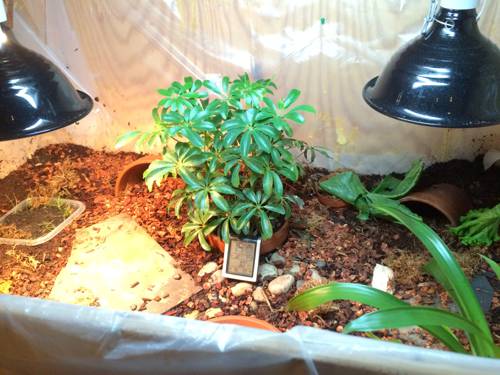
FAQ About Indoor Plant Mulching Techniques

What is indoor plant mulching?
Indoor plant mulching involves applying a layer of material, such as organic or inorganic substances, on the surface of the soil in a plant's pot. This technique is used to retain moisture, suppress weeds, and enhance the aesthetic appeal of indoor plants.

What are the benefits of mulching indoor plants?
Mulching indoor plants offers several benefits, including moisture retention, temperature regulation, reduction of soil erosion, suppression of dust and pests, and enhancement of soil fertility. It also reduces plant stress by maintaining a more stable root environment.

What materials can be used for mulching indoor plants?
Common materials for indoor plant mulching include organic options like shredded bark, wood chips, coconut husks, and inorganic materials such as pebbles, stones, and expanded clay balls. Each type offers different benefits depending on the plant's needs and aesthetic preferences.

How does mulching help in retaining moisture for indoor plants?
Mulching creates a barrier over the soil that slows water evaporation, helping the soil retain moisture for longer periods. This is particularly beneficial in dry indoor environments where water tends to evaporate quickly.

Can mulching affect the soil temperature of indoor plants?
Yes, mulching can help moderate the soil temperature by insulating the soil surface. This keeps the roots of the indoor plants cooler in warm conditions and warmer in cool conditions, protecting them from extreme temperature fluctuations.

Are there any drawbacks to mulching indoor plants?
While mulching has many benefits, over-mulching can lead to issues such as fungal growth and reduced air circulation if organic materials decompose too rapidly. It is essential to use an appropriate amount and type of mulch suited to the specific plant type.

How often should I replace the mulch for indoor plants?
The frequency of replacing mulch depends on the material used. Organic mulches like bark or coconut fibers may need replacement every 6-12 months as they break down, whereas inorganic mulches such as pebbles may not need regular replacement but should be cleaned periodically.

What is the best depth for mulching indoor plants?
A mulch layer of about 2-3 inches (5-7.5 cm) is typically effective for most indoor plants. It's important to ensure that the mulch does not suffocate the plant's base, so leaving a small space around the stem or trunk is advisable.

Can mulching help prevent houseplant pests?
Mulching can help suppress some pests by creating a physical barrier that discourages their emergence. Additionally, it reduces surface moisture that may attract pests like fungus gnats, thereby promoting a drier top layer of soil less appealing to them.

Should different types of indoor plants use different mulches?
Yes, different indoor plants may benefit from various types of mulches depending on their specific needs. For instance, succulents may do well with inorganic mulches like pebbles, while tropical plants might benefit from moisture-retaining organic mulches.

Can I use compost as mulch for indoor plants?
Compost can be used as a mulch for indoor plants as it adds nutrients to the soil. However, it should be used sparingly and replaced often, as it breaks down quickly and can attract pests or lead to mold if not monitored closely.

How does mulching improve soil fertility for indoor plants?
As organic mulches decompose, they release essential nutrients back into the soil, enhancing its fertility. This process mimics natural soil-building processes, promoting healthier growth conditions for indoor plants.

What role does mulching play in weed suppression for indoor plants?
Mulching suppresses weeds by blocking sunlight, which prevents weed seeds from germinating. This reduces competition for resources like water and nutrients, allowing indoor plants to thrive without interference from unwanted plants.

How can I ensure proper air circulation when mulching indoor plants?
To ensure proper air circulation, avoid overpacking the mulch around the plant's base. Maintain a loose layer and keep a gap between the mulch and the plant stem to prevent suffocation and promote airflow.

Is it beneficial to mulch all types of indoor plants?
While many indoor plants can benefit from mulching, some might not require it or could react negatively depending on the specific mulch type. It’s important to consider the plant's natural habitat and growth requirements before mulching.

How does mulching affect watering frequency for indoor plants?
Mulching generally reduces the need for frequent watering by retaining moisture in the soil. However, it’s important to monitor soil moisture levels closely and adjust watering schedules accordingly to prevent overwatering.

Can I mix different mulch types for indoor plants?
Yes, mixing different types of mulch can provide multiple benefits and an appealing aesthetic. Combining organic and inorganic materials may help balance moisture retention with aesthetic and functional needs.

Does mulching influence the pH of the soil for indoor plants?
Some organic mulches may affect soil pH as they break down, potentially altering the soil's acidity or alkalinity over time. It is advisable to monitor the pH periodically and adjust as needed for optimal plant health.

Can mulching enhance the aesthetic appeal of indoor plants?
Mulching not only provides benefits for the plant's health but also enhances the visual appeal of indoor plants. Decorative mulches like colored stones or bark can complement the indoor decor, offering a polished look.

What are common mistakes to avoid when mulching indoor plants?
Common mistakes include over-mulching, using incompatible mulch materials, neglecting mulch replacement, and placing mulch too close to the plant's stem. Avoiding these errors can help ensure that mulching enhances rather than harms indoor plant health.
